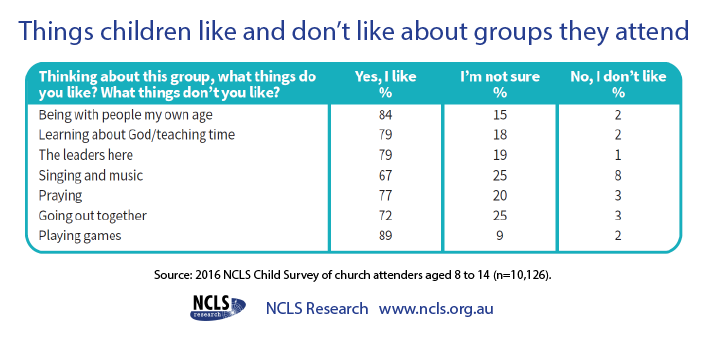Many churches have activities and programs for children’s involvement in church.
In the 2016 NCLS, we investigated how children evaluate their sense of belonging, their connections and how they relate to each other in activities and adult church services. Children were asked to give feedback on church groups or activities for children or youth, like Sunday School and Kids’ Club, as well as church worship services.
Activities
Children were asked to give feedback on church groups or activities for children or youth, like Sunday School and Kids’ Club.
Eight out of 10 children say they like going to the groups or activities, with 53% saying always and 31% saying most of the time. As well, results show that 12% of children like it sometimes. At the lower end of the percentages (4%) say they do not like it.

Further to this question, the survey evaluated different aspects of their experience. Child attenders were asked to consider what they did and didn’t like about their groups and activities

Most popular aspects of children's groups and activities are: being with people of their own age; learning about God/teaching time; and the leaders.
Least support is for singing and music, where some 8% don't like it and a quarter are unsure (25%). This might mean singing and music is not always popular for all and perhaps at times a choice can be given to simply listen in some activities.
The Child Survey also included some questions about worship services. Where the adults are! The children were able to answer even if they only went to part of the service.
The results show that a majority of children like attending church services (81%), although fewer say they liked it all the time (39%) compared to most of the time (42%).

Children were further invited to share their feelings about the groups. They could respond often, sometimes or never, to the question “When you go to this group do you…” Options included: Feel God is there; Feel bored; Feel happy; Feel safe.
In these groups most children claim to often feel safe (84%), happy (79%) and that they belong. (71%).

Their sense of safety was almost the same in church services as for children’s activities (85%), but lower proportions reported feeling happy in church (70%). About two thirds (65%) said they often felt they belonged in church. Boredom levels were higher in church services (69%).
Conclusion
Local church leaders might want to consider bringing something appealing into their adult worship times, where young minds can often cast adrift. Noting lower levels of belonging and happiness in church services might also compel church leaders to respond with socially inclusive practices of young attenders. Also pertinent is that children express lower levels of a sense of God's presence and lower levels of learning about God in church services. This might suggest churches include age appropriate teaching and learning methods that involve all generations, from children to adults in their worship, prayer, preaching and teaching.
Kathy Jacka and Ruth Powell, NCLS Research with Rod Bennett, WildHive Studios.
The faith profile of child church attenders
Positive results overall show that child churchgoers love God and their churches
People of influence in children's faith formation
Parents remain the most significant role modes of faith
Faith formation in children at church and home
Beliefs, identity and faith practices of child churchgoers
Helping child churchgoers use their gifts and skills
Building capacity for mission and empowering children at church
How do child churchgoers rate their wellbeing?
Children rate their happiness in a number of areas of their life
Social networking amongst child churchgoers
How children use technology and online platforms to connect and grow






